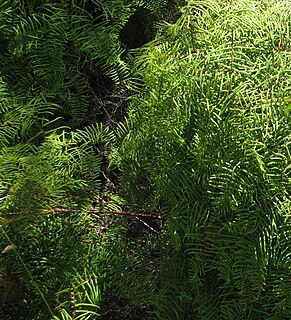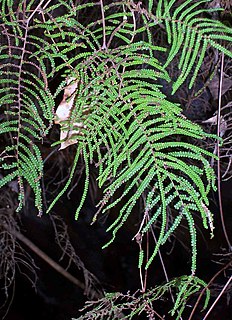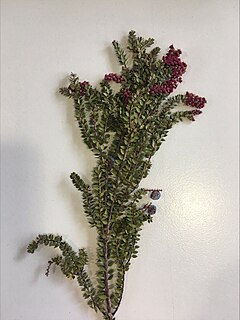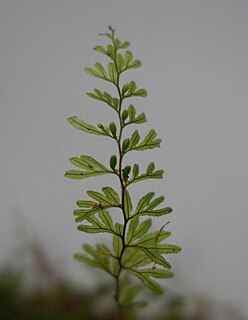
A frond is a large, divided leaf. In both common usage and botanical nomenclature, the leaves of ferns are referred to as fronds and some botanists restrict the term to this group. Other botanists allow the term frond to also apply to the large leaves of cycads, as well as palms (Arecaceae) and various other flowering plants, such as mimosa or sumac. "Frond" is commonly used to identify a large, compound leaf, but if the term is used botanically to refer to the leaves of ferns and algae it may be applied to smaller and undivided leaves.

Diselma archeri is a species of plant of the family Cupressaceae and the sole species in the genus Diselma. It is endemic to the alpine regions of Tasmania's southwest and Central Highlands, on the western coast ranges and Lake St. Clair. It is a monotypic genus restricted to high altitude rainforest and moist alpine heathland. Its distribution mirrors very closely that of other endemic Tasmanian conifers Microcachrys tetragona and Pherosphaera hookeriana.

Athrotaxis cupressoides, is also known as pencil pine, despite being a species of the family Cupressaceae, and not a member of the pine family. Found either as an erect shrub or as a tree, this species is endemic to Tasmania, Australia. Trees can live for upwards of 1000 years, sustaining a very slow growth rate of approximately 12 mm in diameter per year.

Gleichenia is a genus of ferns. Its closest relative is the genus Stromatopteris, restricted to New Caledonia.

Pellaea calidirupium, the hot rock fern, is a fern of eastern Australia and New Zealand restricted to rocky areas in relatively arid environments. In Tasmania, where it is considered rare, it is only found on the East Coast, the Midlands, and lower slopes of the Central Plateau on dry rock faces. It is also found in Victoria and Queensland. The species was originally described from New Zealand.

Gleichenia dicarpa, commonly known as pouched coral fern or tangle fern, is a small fern of the family Gleicheniaceae found in eastern Australia, New Caledonia and New Zealand. It forms tangled thickets in wet places such as swamps and riverbanks.

Gleichenia microphylla is a small fern growing in Australia and New Zealand.
Archeria comberi, also known as the pink mountain heath or comb heath, is a small, rare shrub endemic to Tasmania, Australia. As a member of the heath family, Ericaceae, this species is generally classified as a subalpine/ alpine species and shares many characteristics with other members of the family. It is an evergreen shrub 0.15m-1m in height, with pink flowers during the summer months, hence its common name pink mountain heath. Archeria comberi is often found growing among other species such as Nothofagus gunnii and Persoonia gunnii.

Pomaderris apetala is a small tree or large shrub from the family Rhamnaceae, growing in Victoria, New Zealand and Tasmania.

Polyphlebium venosum, the veined bristle-fern or bristle filmy fern, is a fern in the family Hymenophyllaceae. It is only found in wet forests, mainly growing as an epiphyte on the shady side of the soft tree fern, Dicksonia antartica. It also grows on logs, trunks of trees and rarely on trunks of Cyathea species or on wet rock-faces. It is found in the wetter parts of Eastern Australia and New Zealand. P. venosum has poor long-distance dispersal compared to other ferns due to its short lived spore. Notable features of Polyphlebium venosum include it being one cell layer thick, 5–15 cm in length, having many branching veins and a trumpet shaped indusium.

Gleichenia abscida, commonly known as dwarf coral fern, is an uncommon alpine fern found in southwestern Tasmania. Described by English born dentist and botanist Leonard Rodway, that which distinguishes G. abscida the most from all other species of Gleichenia is its frond. While each other species of Gleichenia have a repetitively branching frond, G. abscida's frond consists of just two blades, with the apical axil between these two blades lacking meristematic tissue.

Astelia alpina called pineapple grass, silver astelia, or perching lily is a commonly found species in alpine and subalpine areas of Tasmania and the Australian Alps. It is a perennial herb that typically dominates its environment by growing in dense clusters, called mats, in alpine bogs. There are two subspecies: Astelia alpina var. novae hollandiae from New South Wales and Victoria and Astelia alpina var. alpina endemic to Tasmania. Both subspecies appear very similar to each other. The species was originally described by Robert Brown.

Trochocarpa thymifolia is a species of flowering plant from the family Ericacae and is endemic to Tasmania. It is a widespread alpine and subalpine shrub with small leaves, pink to red flowers and blue to purple fruit. Originally described by botanist Robert Brown in 1810, it is a widespread Tasmanian endemic that inhabits the state's mountain regions.

Pimelea sericea is a species of shrub in the family Thymelaeaceae. It is native to Australia, specifically Tasmania. Their common name is mountain rice flower. Pimelea means fat and sericea means silk. The reason could be that Pimelea species usually have oily seeds and fleshy cotyledon. The sericea came from the fact that they are covered with silky hair.

Orites acicularis, commonly known as yellow bush, is an angiosperm endemic to Tasmania, Australia and is a member of the genus Orites within the family Proteaceae. The species was first described in 1810 by Scottish botanist Robert Brown in Transactions of the Linnean Society of London.

Hymenophyllum rarum, the narrow filmy-fern, is a species of fern from the family Hymenophyllaceae. This thin-leaved fern is commonly found in New Zealand and Tasmania, growing in patches on rocks and is epiphytic on trees and tree ferns, growing in moist gullies or rainforests. A rather drought tolerant species often found at exposed sites ranging from coastal to montane areas. Forming extensive, interwoven and creeping patches with its thin long (creeping) rhizomes sparsely covered in red-brown hairs, easily recognised by its membranous grey-green fronds, the smooth margins of the pinnae, ultimate segments and indusia; and by the sunken sori in the uppermost segments of the uppermost pinnae. The species can be found throughout Tasmanian rainforests as well as occurring in New South Wales, Victoria and New Zealand on the North and South Islands as well as, Stewart, Chatham and Auckland Islands.

Trochocarpa cunninghamii is a flowering plant species of the family Ericaceae. It is commonly referred to as straggling purpleberry due to its round flattened mauve drupe fruits. This woody shrub is usually found in the understorey of rainforests and subalpine forests in the Central Plateau and western Tasmania, and is endemic to Tasmania.

Hymenophyllum peltatum, is a species of filmy fern widely distributed across Australia, New Zealand, South Africa, South America. Predominantly a rainforest species with delicate foliage arrangements, also known as the 'alpine filmy-fern'. Members of the Hymenophyllaceae family display almost translucent fronds, bearing thickness of just a single cell.

Sticherus tener, also known as silky fan-fern, is a common native ground-fern in the family Gleicheniaceae. It occurs growing along watercourses and drainage lines in rainforest that are dominated by Nothofagus cunninghamii. In Australia, it occurs in the states of Tasmania and Victoria. In New Zealand, it is known from two disjoint regions on the South Island. Like in other members of this genus, Sticherus tener have bright green fronds with repeatedly forking branches, branches bearing linear-shaped segments at almost right angles to the axis and form umbrella-like bush colony.

Leptecophylla parvifolia, commonly known as the mountain pinkberry, is a small to medium sized shrub within the Ericaceae family and is endemic to the highlands of Tasmania. This species was first collected and documented in 1804 by Robert Brown and was formerly included in the Cythodes genus. It was then as noted as subspecies of Leptecophylla junipernia but in 2018, was classified as its own species




















